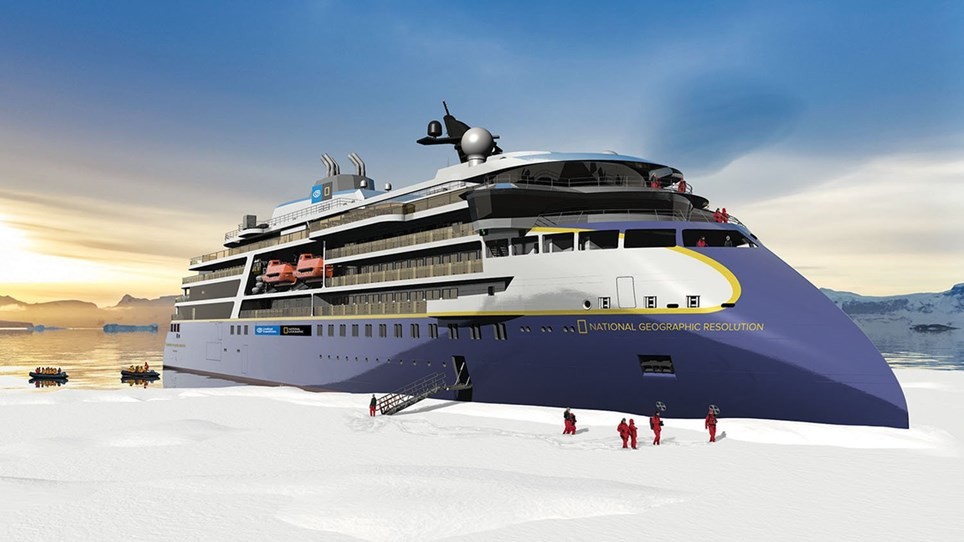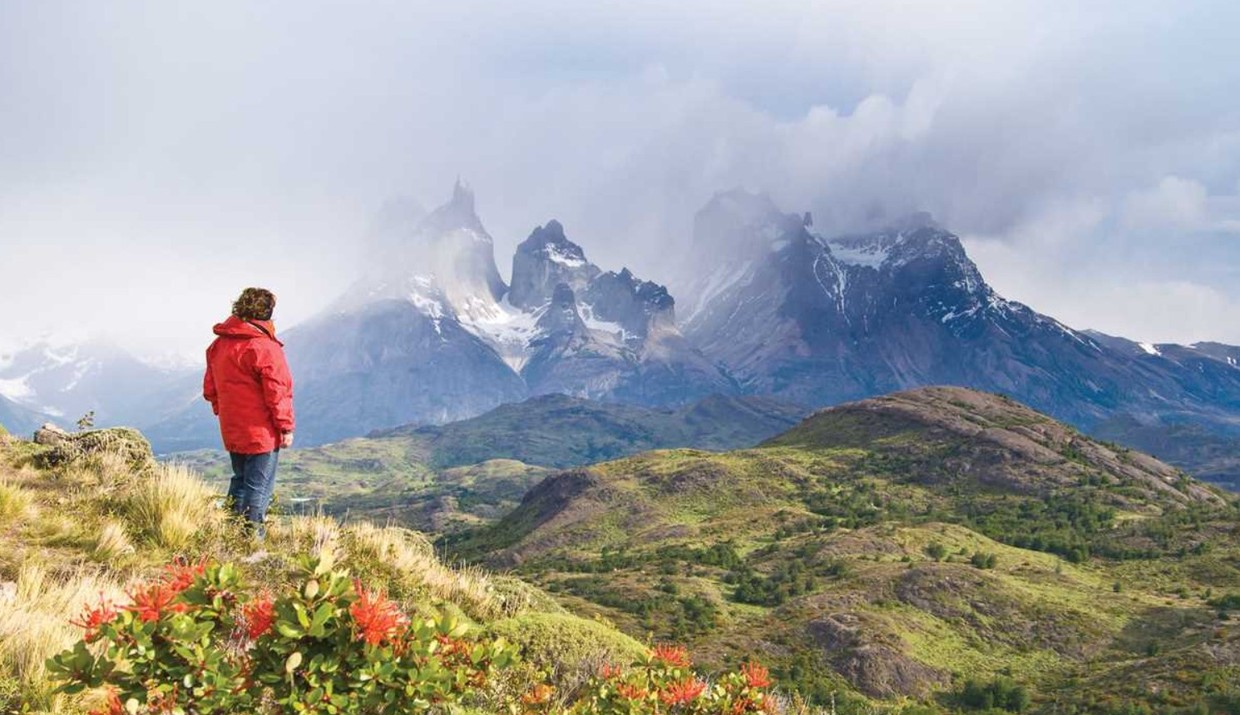from$ 26300 AUD
Note: Current p/p indicative rate. Final price may change due to currency fluctuations.
National Geographic Resolution
Punta Arenas to Ushuaia
Overview
The southernmost realms of the planet are places of unimaginable beauty: Patagonia and Antarctica. Humpback whales breach and penguins gather by the thousands. Icebergs shimmer and sapphire-hued fjords harbor snowcapped peaks and virgin forests. Join us on an odyssey aboard the National Geographic Orion that combines the celebrated wonders of the Antarctic Peninsula, southern Patagonia, and the Chilean fjords—all in a single epic voyage. Follow in the wake of legendary explorers like Ernest Shackleton and Ferdinand Magellan to encounter otherworldly icescapes and calving glaciers, remote reserves and pristine parks, and the incredible creatures that thrive at the edge of the world.
Departures
Cruise Itinerary
Arrive in Santiago and settle into the Mandarin Oriental (or similar) before a guided overview of the vibrant Chilean capital backed by the Andes. (L)
Today we fly from Santiago to Punta Arenas, Chile’s southern gateway to Patagonia. Embark National Geographic Explorer or National Geographic Resolution. (B,L,D)
Cruise to Tierra del Fuego and venture into the archipelago’s largest protected land area: Karukinka Natural Park. Visit this private reserve by special permission, searching for Andean foxes, guanacos, black-browed albatross, and more. Then sail to Ainsworth Bay, a stunning fjord surrounded by subpolar forest, keeping an eye out for elephant seals. (B,L,D)
Today, we enter the Strait of Magellan to explore Francisco Coloane Marine Park. The park covers more than 165,000 acres of land and sea and is home to an abundance of wildlife, including humpback whales, two species of sea lions, and Magellanic penguins. Cruise along the coastline by Zodiac and kayak to spot black-and-white Peale’s dolphins, the endangered Chilean dolphin, and Andean condors. (B,L,D)
Early this morning we dock in picturesque Puerto Natales before heading out to explore majestic Torres del Paine National Park, a UNESCO Biosphere Reserve. Set out by foot or by vehicle across the windswept, rugged landscape, which spans more than 550,000 acres and harbors an astounding variety of geological forms, from the soaring granite pillars of the “horns” to windswept grasslands to rivers, glaciers, and gem-colored lagoons. Keep an eye out for guanacos, rheas, foxes, and armadillos. (B,L,D)
Local pilots will join our Captain on the Bridge to guide us through the winding Kirke Narrows, accessible only to small expedition ships. We then continue our discovery of the Chilean fjords where we may explore by ship or take a forest walk. (B,L,D)
Sail into southern Patagonia’s vast wilderness of forested isles, mirror-like lakes, and snowcapped peaks. Myriad fjords cut between soaring granite walls and waterfalls tumble from high above. Explore the region known as Chile’s “Glacier Alley,” part of the UNESCO- recognized Cape Horn Biosphere Reserve. Cruise into the secluded Pia Fjord, admiring views of its massive glacier; and glide into Garibaldi Fjord in Alberto de Agostini National Park, where the Andes meet the sea. Get up close to the monumental wall of ice that marks the edge of Garibaldi Glacier, exploring by Zodiac or kayak. Continue to Agostini Fjord, where numerous glaciers originate from the nearby mountains, for a chance to witness thunderous glacial calving. (B,L,D Daily)
Sail to Antarctica via the Drake Passage, named after 16th-century English admiral Sir Francis Drake. Watch for dozens of species of seabirds gliding alongside our ship—including the albatross, which boasts the longest wingspan of any extant bird—and enjoy talks from our onboard naturalists about the wildlife and geology that await us on the Antarctic Peninsula. (B,L,D)
With long hours of daylight at this time of year, we have ample opportunities to explore. Our schedule is flexible, allowing us to take advantage of the unexpected, whether we’re watching whales at play off the bow of our ship or enjoying an evening Zodiac cruise amid glittering icebergs. One day, we might set out by kayak to encounter towering icebergs at water level; embark on a Zodiac excursion in search of seals and blue-eyed shags; or walk on a beach amid thousands of Adélie and gentoo penguins. The next, we might experience the thrill of the ship crunching through pack ice. Our expert expedition team will enrich our experiences. (B,L,D Daily)
Relax onboard and enjoy the ship’s amenities as the coast of Antarctica disappears from view. Round the southernmost tip of South America at Cape Horn and witness the dramatic meeting of the Atlantic and Pacific Oceans en route to Ushuaia, Argentina. (B,L,D Daily)
Disembark in Ushuaia and board our flight to Santiago to connect with your overnight flight home. (B,L)
Itineraries are subject to change.
National Geographic Resolution

Vessel Type: Expedition Ship Passenger Capacity: 126 Built: 2020 A next-generation expedition ship, purpose-built for polar navigation. National Geographic Resolution is a next-generation expedition ship, purpose-built for polar navigation. A twin to National Geographic Endurance, she is a fully stabilized, highly strengthened, ice-class Polar Class 5 (PC5) vessel, it is designed to navigate polar passages year-round, and safely explore uncharted waters, while providing exceptional comfort. Its patented X-BOW® is key to its design; its powerful wave-slicing action provides an extremely smooth ride in even adverse conditions, and even reduces spray on deck, for superior observation. She carries a full suite of expedition tools and offers a variety of experience-enhancing amenities. The luxury of comfort on expedition. National Geographic Resolution comfortably accommodates 126 guests in 69 outside-facing cabins. Cabins are efficiently designed, with sizes range from the 140-square-foot solo cabin to the 430-square-foot category 7 suite. Fifty-three of the 69 cabins, including all 12 of the solo cabins, will feature small balconies with floor-to-ceiling sliding doors that bring in the spectacular views and ample natural light. Comfort & convenience in every room. Every cabin has two portholes, a large window or balcony, and temperature controls. Bathrooms are modern and stocked with botanically inspired hair products, soap, and shower gel, plus a hairdryer. Cabins are equipped with expedition command centers with tablets and USB/mobile device docking, TVs, Wi-Fi connections, and hair dryers. Dining. Food served aboard is fresh, local, and delicious, and sourced from suppliers who share our values of sustainable use whenever possible. Meals aboard are almost always served in the dining room, located aft of the lounge deck. When weather conditions allow, lighter fare may be served on the observation deck. There is no assigned seating and our dining room accommodates the entire expedition community in a single seating. During meals your expedition leader, naturalists, and any guest speakers aboard will join you. Public Areas: Two restaurants, a Chef’s Table for small group dining, Observation Lounge with bar, gym, Wellness area, infinity-style outdoor hot tubs, library, main lounge with full service bar, 24-hour beverage, state-of-the-art facilities for films, slideshows and presentations, and a photo workshop area; plus, an expedition base with lockers for expedition gear, and an “open bridge” for access to our captain, officers and the art of navigation. Meals: Two restaurants, featuring local, sustainable choices and unassigned seating for flexible, inclusive dining; plus a Chef’s table for intimate, small group dining. Main restaurant has 270º views, and the Observation deck restaurant features lighter, made-to-order fare. Special Features: A full-time doctor, undersea specialist, National Geographic photographer, Lindblad-National Geographic certified photo instructor and video chronicler, an internet cafe and laundry. Wellness: The vessel is staffed by our wellness specialists and features a glass-enclosed yoga studio, gym, treatment rooms and spa relax area, and high- and low-heat saunas with ocean views. Expedition Landing Craft. Key to our operation is our fleet of expedition landing craft, which we use to land in places that would otherwise be inaccessible. With 14 of these boats and two loading stations used every time we disembark, we’re able to transfer guests off the ship quickly, so you can be out on adventures, not idly waiting. The expedition landing craft we use are 19 feet long, powered by four-stroke outboard engines, and are capable of comfortably carrying 10-12 people. They are widely recognized as the safest and most versatile small boats afloat. Remotely Operated Vehicle. Capable of reaching 1,000 feet, far beyond the range of any Scuba diver, the ROV allows you to literally view parts of the undersea that are as unexplored as the moon. Chances are you, like many of our guests, will be struck by how surprisingly colorful undersea life is in these unlikely places. And this glimpse may fundamentally change how you view the ocean. Kayaks. National Geographic Resolution will be equipped with a fleet of kayaks large enough to ensure everyone who wants to can paddle at every opportunity. Consequently, prior kayaking experience isn’t necessary—many of our guests have their first kayaking experience in extraordinary locations. Our custom-designed floating platform lets us deploy kayaks from the ship, or any location we want—including far from shore. Kayakers are usually free to explore where they want within boundaries set by the undersea specialist and officer of the watch. Underwater camera. Our undersea specialist will dive often during your expedition, even in polar regions, with cold-water gear, to shoot high-definition, Cousteau-like footage of the deep. Colorful nudibranchs, swimming, plant-like crinoids, and mysterious fish with antifreeze blood that thrive in the frigid sea will give you an entirely new appreciation of the marine environment. Video microscope. Naturalists will use the video microscope to help explain all elements of the environment, including tiny organisms that are the building block of the marine ecosystem. Spellbinding live views of krill at 80x magnification fills the high-definition screens in the lounge with vivid detail, and fills every onlooker with a sense of wonder at the importance of otherwise unobservable creatures. Hydrophone. This underwater microphone is deployed to listen to the vocalizations of marine mammals. Real time transmissions of their eerie, haunting sounds can be broadcast through the ship or recorded for later playback. Few experiences in nature are as captivating as watching humpback whales feed close to the ship as their vocalizations play through the ship’s PA system. Electronic charts. An electronic chart showing the ship’s location, course, and speed is almost always on display in the lounge. Open bridge. You’ll find our captains are engaged, knowledgeable members of your expedition who are eager to share their passion with you. National Geographic Resolution's open bridge features comfortable spaces to sit, enjoy the view, drink your morning coffee, or simply chat with the officers. Snorkeling gear & wetsuits. On warm weather itineraries where there will be snorkeling, you’ll select a mask, snorkel, fins, and wetsuit that remain yours for the duration of the expedition. There’s no need to pack and tote your own gear, although guests who prefer to are welcome to bring their own.
Highlights
• Seek out Antarctica’s iconic wildlife—including penguins, seals, and killer whales—and marvel at incandescent icebergs using our fleet of kayaks and Zodiacs • Navigate Chile’s coastal fjords and explore spectacular Glacier Alley, where monumental glaciers calve into the sea • Hike among the snowcapped “horns” of Torres del Paine National Park and enjoy special access to Karukinka Natural Park, the largest protected land area in Tierra del Fuego • Cruise the waters of Francisco Coloane Marine Park, searching for the humpback whales and dolphins that inhabit this vast marine reserve
Map



